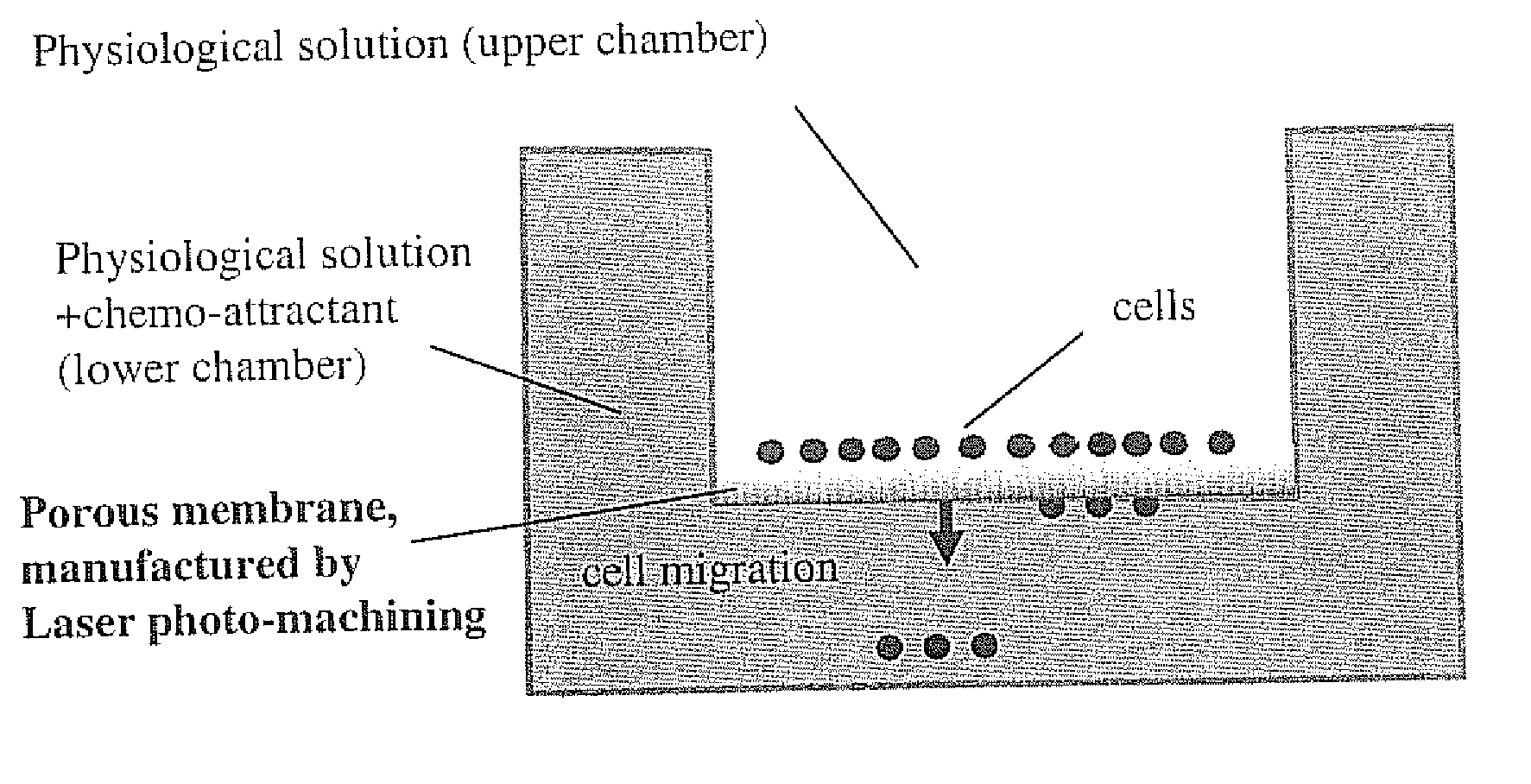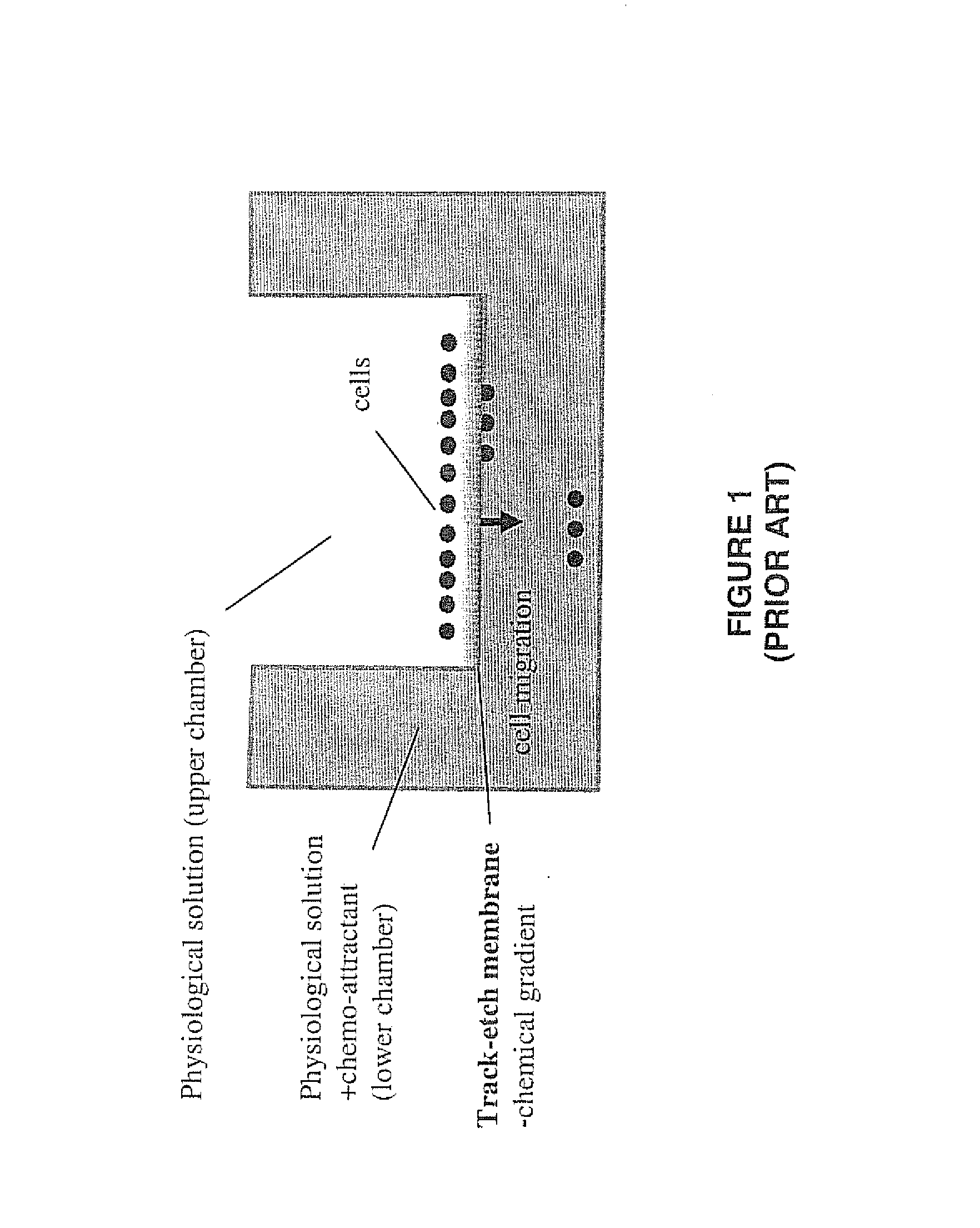However, due to the random nature of the
ionization particle bombardment, pore density has a practical upper limit so as to avoid the random occurrence of “doublets”, i.e. two pores touching each other.
While being the current
gold standard, and clearly dominating the research market, there are several disadvantages to the current Boyden chamber systems.
Because Boyden chambers rely on passive chemical
diffusion in order for a gradient to be formed between the upper and lower reservoirs, there is no
active control of the gradient process.
Not having the ability to modulate or control the time varying aspect is a
disadvantage of this approach.
In addition, because of the random spatial location of the pores formed by the track-etch process, the chemical
diffusion gradient is also very non-homogeneous at the top surface of the membrane.
Lastly, the transient and non-homogeneous nature of the chemical gradient using current methods can cause time-sensitive, and
concentration cell migration responses.
These in turn can cause artifacts where, depending on the timing and or concentration of the
agonist, it is impossible to determine if a reduction in
cell migration is due to a degradation of the chemical gradient, or the effect of an experimental pharmacological agent.
However, although the gradients are quantitatively characterized, none of the micro-fluidic approaches have eliminated the temporal and transient nature of the gradient formation and the potential artifacts this can cause.
As such getting fluids and living cells into micro-fluidic chambers is cumbersome, and typically researchers end up working with very small fluid volumes which are prone to
evaporation effects.
Physiological buffering agents can cause osmotic stress to living cells in the presence of even minor amounts of
evaporation.
Another drawback of the micro-fluidic approaches is that they tend to provide very shallow chemical gradients, on the order of a percent or two of
absolute concentration change across a
cell diameter.
The concentration gradients achieved in microfluidic devices are on this order or smaller, as such the microfluidic solutions tend to be limited in their chemotactic efficiency (the number of cells which respond).
So while there are some advantages to the microfluidic approaches, to date, none of the microfluidic-based commercial solutions has supplanted the Boyden chamber has the dominant “
gold standard” measurement
system for
in vitro chemotaxis.
The practical
impact of requiring a fluorescent
label to effectively “count” the cells is a big
disadvantage in running these types of assays.
Secondly using fluorescent or optical dye labeling techniques makes the assays more expensive as the labeling step and reagents cost time and money.
Lastly, the presence of labels can make it is necessary to introduce non-homogeneous work-flow
processing steps.
Any manual process like cell scraping takes more time, interrupts the
workflow, thereby limiting
assay throughput, and introducing dominant errors in the quantitation of the response.
It is not enough however, that the substrate be optically clear, it must also not introduce any significant
phase perturbation to the optical
wavefront which would distort or
mask the subtle phase variations introduced by the biological cells.
Phase-sensitive imaging is not amenable to the current commercially-available Boyden chamber
consumables which rely on porous membranes manufactured by the track-etch manufacturing process.
As such, commercially available Boyden chamber geometries are not amenable to direct cell viewing.
Unfortunately this
advantage has not overcome the disadvantages associated with relatively shallow chemical gradients and
evaporation effects.
Another
disadvantage of currently available Boyden chamber derived chemotaxis kits is that they require large number of cells to characterize the response, typically tens to even hundreds of thousands of cells per well.
Large cell numbers can be a major cost / adoption disadvantage.
This is especially the case when using rare, and perhaps difficult to isolate primary hematopoietic cells from the blood.
The
dynamic range problem is further complicated in that often researchers are interested in finding compounds which inhibit the chemotactic response.
Detection of very
small cell numbers of migrating cells from the starting
population is difficult to do with current commercial systems as it is not easy to image the various surfaces where the cells are located (top side of membrane, bottom side of membrane or lower reservoir).
This may require the need for time-consuming, manual
assay steps such as “manual cell scraping”, in order to separate the fluorescent
signal on the top side of the membrane vs. the fluorescent
signal on the bottom side of the membrane.
These types of steps are prone to
human error and variability and are greatly detrimental to the precision of a Boyden chamber chemotaxis
assay.
Unfortunately, the Fluoroblok™
consumables are relatively expensive, the technique still requires fluorescent labels, it is not easy to image the cells or observe
cell morphology and the systems require large numbers of cells per well.
However, the commercial solutions for the Boyden chamber geometry all suffer from the following disadvantages:
Are either extremely low
throughput, or cumbersome to use
 Login to View More
Login to View More 


